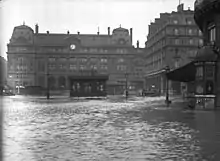1910 Great Flood of Paris
The 1910 Great Flood of Paris (French: Crue de la Seine de 1910) was a catastrophe in which the Seine River, carrying winter rains from its tributaries, flooded the Paris conurbation, France. The Seine water level rose eight metres above the ordinary level.[1]

Chronology

In the winter of 1909–1910, Paris and the surrounding area experienced higher than normal rainfall which saturated the ground and filled rivers to overflowing. In January 1910, Parisians were preoccupied with daily life and lulled into a false sense of security because the Seine's waters level had risen and fallen again in December. Consequently, they largely ignored reports of mudslides and flooding occurring upriver. They were also slow to notice warnings signs within the city as the Seine's water level rose eight meters higher than normal,[2] its water began to flow much faster than normal, and large amounts of debris appeared.[3] By late January, the Seine River flooded Paris when water pushed upwards from overflowing sewers and subway tunnels, then seeped into basements through fully saturated soil and from the sewer system that got backed up, which led to the basements of several buildings sustaining damage.[4] The waters did not overflow the river's banks within the city, but flooded Paris through tunnels, sewers, and drains. These larger sewer tunnels were engineered by Baron Haussmann and Eugene Belgrand in 1878 which magnified the destruction caused by the flood in 1910.[5] In neighbouring towns both east and west of the capital, the river rose above its banks and flooded the surrounding terrain directly.
Winter floods were a normal occurrence in Paris but, on 21 January, the river began to rise more rapidly than normal. This was seen as a sort of spectacle where people were actually standing in the streets watching the water rise in the Seine.[5] Over the course of the following week, thousands of Parisians evacuated their homes as water infiltrated buildings and streets throughout the city, shutting down much basic infrastructure. The infrastructure was more vulnerable to flooding because most of it was built within the sewage system in order to avoid cluttering the streets.[4]
Police, firefighters, and soldiers moved through waterlogged streets in boats to rescue stranded residents from second-story windows and to distribute aid. Refugees gathered in makeshift shelters in churches, schools, and government buildings. Although the water threatened to overflow the tops of the quay walls lining the river, workmen were able to keep the Seine back with hastily built levees.
Once water invaded the Gare d'Orsay rail terminal, its tracks soon sat under more than a metre of water. To continue moving throughout the city, residents traveled by boat or across a series of wooden walkways built by government engineers and civilians.
On 28 January the water reached its maximum height at 8.62 metres (28.28 feet) above its normal level.[4] In March, the Seine finally returned to normal levels.
Consequences
Estimates of the flood damage reached some 400 million francs, or $1.5 billion in today's money. The flooding lasted nearly a week, according to one report.[6] Remarkably, despite the damage and duration of the flood, no deaths were reported.
There were fears that an outbreak of disease would occur after debris from flooded homes piled into the streets.[3]
Literature and Media
- The Knowledge of Water by Sarah Smith, Ballantine, New York (1996) ISBN 0-345-39135-7
- The flood provided the setting for the 2011 animated film A Monster in Paris.
- In Stealing Mona Lisa (2011) by Carson Morton, the flood is the setting of the climax of the novel. ISBN 9780312621711
- In Bertrand Bonello's 2023 film, The Beast, the flood is depicted.
Image gallery
 Pont Alexandre III during the flood
Pont Alexandre III during the flood rue de la Convention
rue de la Convention.jpg.webp) Avenue Félix-Faure
Avenue Félix-Faure Cour de Rome, gare Saint-Lazare
Cour de Rome, gare Saint-Lazare Rue de Poitiers
Rue de Poitiers Rue de Seine
Rue de Seine Rue Trousseau
Rue Trousseau Trousseau Square
Trousseau Square
References
- "Is Paris prepared if Seine floods?". BBC. 27 December 2013. Retrieved 27 September 2014.
- Guguen, Guillaume (6 March 2016). "Paris region prepares in case of 'flood of the century'". France 24. Retrieved 17 October 2017.
- Jackson, Jeffrey (2010). Paris Under Water: How the City of Light Survived the Great Flood of 1910. New York, NY: Palgrave MacMillan. ISBN 978 0-230-61706-3.
- Jackson, Jeffrey H. (2010). Paris under water : how the city of light survived the great flood of 1910 (1st Palgrave Macmillan pbk. ed.). New York, N.Y.: Palgrave Macmillan. ISBN 978-0230108042.
- Jackson, Jeffrey H. (2010). Paris under water : how the city of light survived the great flood of 1910 (1st ed.). New York: Palgrave Macmillan. ISBN 978-0230617063.
- 7 January 2010, The Guardian, Flooding in Paris in 1910 Accessed 16 Dec 2010
Sources
Jeffrey H. Jackson, Paris Under Water: How the City of Light Survived the Great Flood of 1910 (NY: Palgrave Macmillan, 2010)
External links
![]() Media related to Great flood of Paris in 1910 at Wikimedia Commons
Media related to Great flood of Paris in 1910 at Wikimedia Commons
- Crue de la Seine (in French)
- Postcard collection of flood photographs
- Images by photographer Pierre Petit
- Assemblée nationale website on the 1910 flood (in French)
- The flood's impact on Parisian hospitals Archived 31 October 2007 at the Wayback Machine (in French)
- L'explosition virtuelle Paris Inondé 1910: Galerie des bibliothèques, Ville de Paris
- Revisiting the flood 100 years later